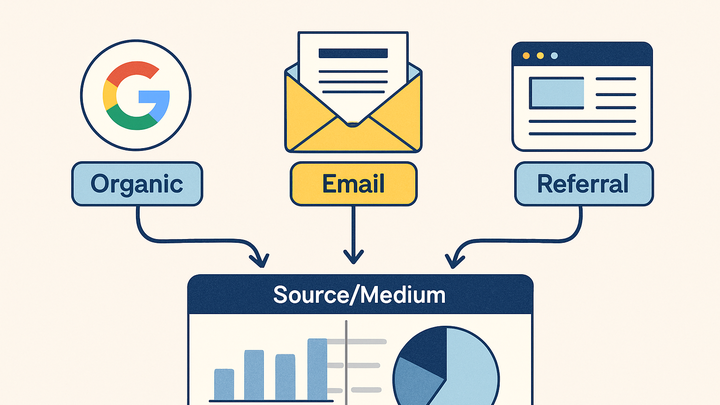Published on 2025-06-26T04:30:34Z
What is Source/Medium? Examples in Analytics
In web analytics, Source/Medium is a composite dimension combining the origin of traffic (source) with the channel used (medium). It allows marketers and analysts to attribute and segment visitors based on how they arrive at your site—whether through organic search, direct visits, referral links, email campaigns, or paid ads. Tools like Google Analytics 4 (GA4) and PlainSignal leverage Source/Medium to categorize sessions and evaluate campaign performance. In GA4, you can find Source/Medium under the Traffic acquisition report; in PlainSignal’s cookie-free, privacy-focused dashboard, it appears in the Acquisition section. Properly tagging URLs with UTM parameters ensures accurate Source/Medium reporting, enabling deeper insights into user behavior and ROI. By understanding where your traffic comes from and the channels driving it, businesses can optimize marketing budgets, tailor content strategies, and improve conversion rates. Source/Medium forms the backbone of traffic attribution in modern analytics platforms.
Source/medium
Source/Medium combines traffic origin and channel into a single dimension for accurate attribution and segmentation in web analytics.
Understanding Source vs Medium
Source/Medium splits into two parts: the source identifies where the user came from (e.g., Google, newsletter.example.com, or a referral site), while the medium specifies the channel type (e.g., organic, email, referral, cpc). Together, they provide granular visibility into traffic origins and paths.
-
Source
The specific origin of your website’s traffic, such as a search engine name, social network, or referring domain.
-
Medium
The general category of the source, like organic search, paid search, referral, or email, which groups traffic into broader channels.
Importance of Source/Medium in Analytics
Accurate Source/Medium data is essential for understanding marketing performance, optimizing channels, and making data-driven decisions about budget allocation and content strategy.
-
Attribution accuracy
Helps determine which marketing efforts contribute most to conversions by tracing user paths back to their original source and channel.
-
Campaign performance monitoring
Enables you to compare organic, paid, email, and referral campaigns side by side to identify highest-ROI channels.
-
Traffic segmentation
Allows segmentation of audiences based on where and how they discovered your site, informing personalized content and targeting strategies.
Implementing and Analyzing Source/Medium
Walkthroughs for setting up proper Source/Medium tracking and interpreting the data in GA4 and PlainSignal.
-
GA4 analysis of source/medium
In GA4, navigate to Reports > Acquisition > Traffic acquisition, then set the primary dimension to ‘Session source / medium’ to view and filter traffic data by source and medium.
-
Accessing source/medium report
Go to Reports > Acquisition > Traffic acquisition and select ‘Session source / medium’ as the dimension.
-
Customizing reports
Apply filters or build custom explorations to break down Source/Medium data by additional dimensions like Device, Landing Page, or Geography.
-
-
PlainSignal tracking setup and analysis
Add PlainSignal’s snippet to your site to capture Source/Medium without cookies:
html <link rel="preconnect" href="//eu.plainsignal.com/" crossorigin /> <script defer data-do="yourwebsitedomain.com" data-id="0GQV1xmtzQQ" data-api="//eu.plainsignal.com" src="//cdn.plainsignal.com/plainsignal-min.js"></script>This script infers the source and medium from referrer data and UTM tags. View Source/Medium metrics in the PlainSignal dashboard under the Acquisition section to analyze traffic channels.-
Integrate script
Copy and paste the PlainSignal snippet into your site’s <head> to begin tracking without cookies.
-
View source/medium in dashboard
In PlainSignal’s UI, open the Acquisition report to see traffic broken down by Source/Medium over different time periods.
-
